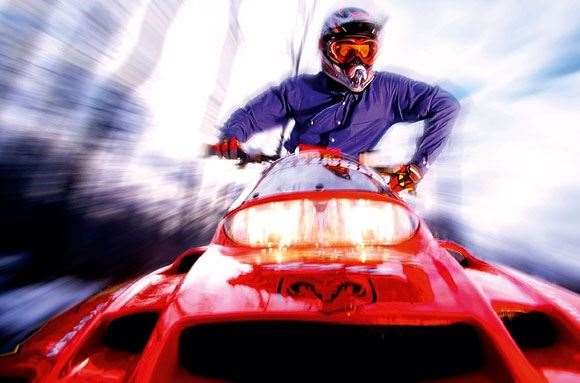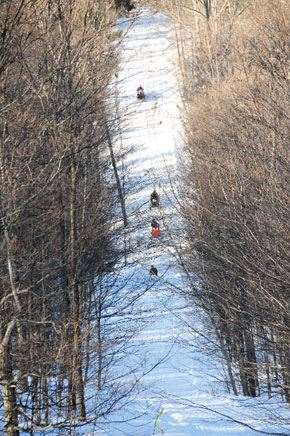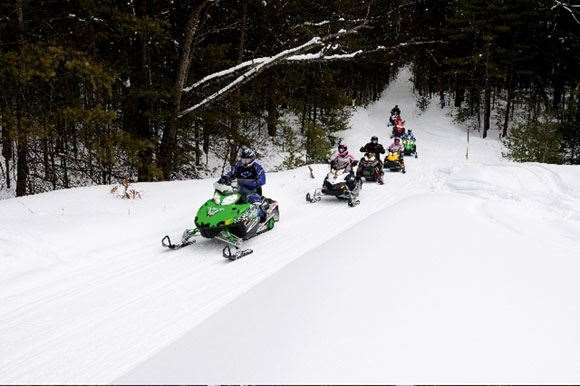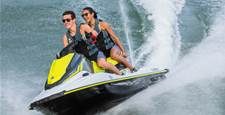You don't have to be a crusty demon to sample the exhilaration of snowmobiling in Canada.
You don't have to be a crusty demon to sample the exhilaration of snowmobiling in Canada.
 The best way to see Canada. Image: Getty Images
The best way to see Canada. Image: Getty ImagesIt was around the moment my helmet visor iced over and my vision fell to about five metres that I realised how fast I’d been going. In front of me loomed a 60m descent from a ridge, which seemed to fall almost vertically before turning into three miles of loopy crests through a narrow passage in the cedar forest. Behind me were five snowmobile riders accelerating up the steep switch-backs to the ridge I was sitting on. My Canadian mate, Brent, had warned me that if I needed to stop when snowmobiling with a group, I should always move to the right of the trail or I’d be spitting out pieces of skidoo for weeks.
So I did what Canadians do when sitting on a 600cc snowmobile in the middle of the Ontario wilderness: I gunned that Arctic Cat and leapt into the abyss, hitting 80km/h before reaching the bottom and boosting up the other side like a rollercoaster on snow.
Reaching the top, the sled got some air and only properly landed again as I careened down the other side, the sound of a wrung-out two-stroke screaming in my ears as I kept the power on. For the next five or six minutes we dove and crested across the beautiful winter landscape of southern Ontario, my own whoops competing with the screaming noise of the sled.
After an hour we’d ascended more than 400m to the top of the mountain that contains Talisman ski field. Looking out over exhilarating scenery – my heart pounding – I realised why Canadians love this sport so much: there isn’t any better way of touring a northern winter than grabbing a bunch of people and hitting
the snowmobile trails.
 Roaring through the forest. Image: Mark Abernath
Roaring through the forest. Image: Mark AbernathIn the east of this vast country – Ontario and Quebec in particular – the snowmobile trails are so well-developed they create an alternative winter transport route. In Ontario the combined efforts of clubs, landowners, councils and provincial government have created more than 43,000km of maintained trails for snowmobile riders – it’s apparently the largest network of sled trails in the world.
The trails I was sledding on in the Grey County area of Ontario are maintained by the Klondyke Groomers, a club of snowmobile enthusiasts who groom trails, maintain signage and provide
a clubhouse where you can warm up with hot chocolate and French fries. The trails are about as wide as an inner-city lane and most of them are groomed every morning. Some trails wind through forests, lope across open country and others skirt around lakes or along disused railway embankments.
I was loaned an Arctic Cat sled by my friend, Karyn, and went touring with locals Terry, Brent, Greg, Beaver and Mike. On a wintry Sunday we rugged up in jackets, bib-pants and boots that are rated to -50 degrees and went motoring in the wilderness.
Through the backblocks of southern Ontario you see the things you don’t spot from the freeways: the abandoned barns, the horse trails and, of course, the wildlife – which in southern Ontario means deer, coyotes and hawks.
Most snowmobile trails feature way-stops such as clubhouses, filling stations, bar-restaurants (or “warm-up shacks”) with wood stoves and barbecues. In the forested hills between Flesherton and Markdale, we come around a corner and in front of us are 50 snowmobiles parked outside the Klondyke
Trail Groomers clubhouse.
The locals say the best way to tour is with a snowmobile club which travels in large groups and organises barbecues. But be warned: in Ontario, drink-driving and dangerous driving laws apply to the snowmobile trails, and they’re enforced. On an old railway embankment out of Proton Station, our group comes to a stop in a line of 50 snowmobiles while the OPP – Ontario Provincial Police – conducts checks of sleds, paperwork and evidence of alcohol intake. The police are well set up to cruise these trails, right down to the flashing lights on the front and back of their black-and-white snowmobiles.
The sleds easily carry two people and are surprisingly warm, with good fairings and warmed seats and handle bars. The two-stroke engine is attached to a continually variable transmission (CVT), so there’s no changing of gears. People of all ages ride them in Canada and you don’t have to be a motorcyclist to be safe on a snowmobile.
The main differences between motorbikes and snowmobiles are the throttle and handling; the throttle on a sled is a spring-loaded lever on the right grip, which you squeeze inwards with your thumb. The handling’s the most difficult part ... for me. A motorcyclist since my teens, the first time I rode a snowmobile I struggled with something that felt like a motorbike yet couldn’t be “turned-in” at a corner. However, the suspension systems at the front of the sleds are very sophisticated and once I realised the machine wouldn’t roll, I was going flat out through the bends.
While some sleds are capable of revving along at more than 160km/h, the cruising speed on the trails is limited to 50. There’s also signs warning of bridges and road crossings, and these signs should be obeyed. A week after my most recent snowmobiling tour, someone using the same trails was killed when he crossed a road as a pick-up truck was hurtling down it.
This isn’t to say Canadians don’t like hooning on their sleds: they do. It’s just that if you want to race, do jumps or try some pond-skimming (riding your sled over the top of the water like a jet-ski), then you do it on a friend’s farm, not on the public trails. The trails are two-way and a misbehaving rider is simply a danger to the oncoming traffic.
Expect also to meet long-distance tourers while you’re riding the trails. These riders do 1600km group treks they call “saddlebag tours”. In one warm-up shack in Bruce County, I meet a group of Minnesotan retirees who are doing a tour around the top of the Great Lakes.
 Snow Touring. Image: Mark Abernath
Snow Touring. Image: Mark AbernathWhat I really like about the Canadian snowmobile trails is that you don’t have to go far from the city to find the wilderness. It’s quite something to grab a coffee at a warm-up shack in the middle of nowhere and see coyote tracks in the snow while watching red-shouldered hawks circle their turf, all less than two hours’ drive north of Toronto.
My day ends at The Homestead, a bar and restaurant in the middle of the wilderness. Over a beer and a burger the local rednecks tell their tales of the cougar that catches horses and the fox that lures farm dogs into the fox-traps. One of the locals wants to know if it’s true that kangaroos stand eight feet tall and can tear off a man’s head. It isn’t entirely true, I say, “Although, there was this one time just out of Parkes ... ”
For anyone wanting to see the real Canada, I’d recommend snowmobile touring: these machines are fast, fun and give you a dose of adrenaline to go with the sightseeing. Just one piece of advice to travelling Aussies: if the locals tell you to dress up in an outfit that makes you look like a cross between an astronaut and the Michelin Man, just do it. No one knows cold weather like a Canadian.
– Mark Aberneth
Related Articles

Australian Diamonds series with England cancelled

Round 2 Suncorp Super Netball Pic Special













